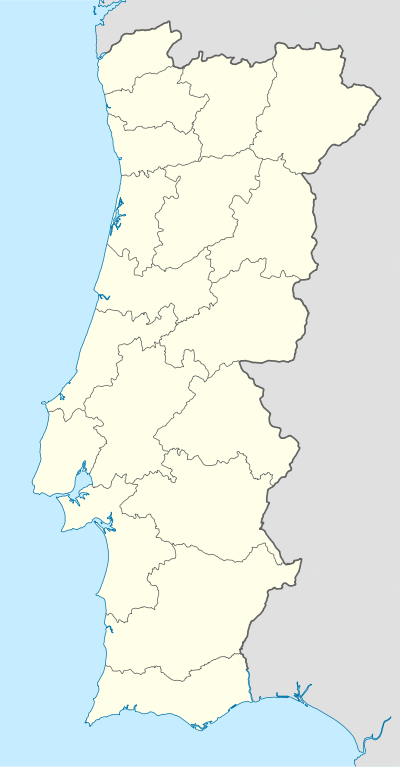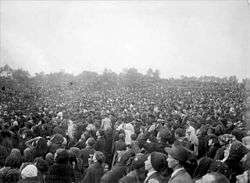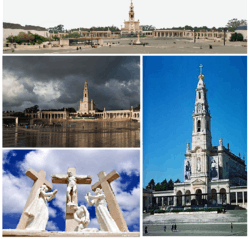Fátima, Portugal
| Fátima | |||
|---|---|---|---|
| Parish | |||
|
The pilgrims and visitors of Fátima in front of the Shrine of Our Lady | |||
| |||
 Fátima | |||
| Coordinates: 39°37′N 8°40′W / 39.62°N 8.66°WCoordinates: 39°37′N 8°40′W / 39.62°N 8.66°W | |||
| Country | Portugal | ||
| Region | Centro | ||
| Subregion | Médio Tejo | ||
| Intermunic. comm. | Médio Tejo | ||
| District | Santarém | ||
| Municipality | Ourém | ||
| Area | |||
| • Total | 71.84 km2 (27.74 sq mi) | ||
| Population (2011) | |||
| • Total | 11,596 | ||
| • Density | 160/km2 (420/sq mi) | ||
| Postal code | 2496 | ||
| Area code | 249 | ||
| Patron | Nossa Senhora dos Prazeres and Nossa Senhora de Fátima | ||
| Website | http://www.jf.fatima.pt/portal/ | ||
Fátima (Portuguese pronunciation: [ˈfatimɐ]) is a civil parish in the municipality of Ourém, in the Portuguese Santarém District. The population in 2011 was 11,596,[1] in an area of 71.84 km².[2] The parish encompasses several villages and localities of which Fátima, with a population of 7,756 residents, is the largest. Part of the urban agglomeration of Leiria, it is 187 km (116 mi) south of Porto and 123 km (76 mi) north of Lisbon. It has been permanently associated with the Marian apparitions that occurred in Cova da Iria in 1917 and which were later recognized by the Catholic Church.
History


The name of the town and parish is a rendition of the Arabic given name Fatima ( فاطمة Fāṭimah), reportedly[3] the name of a Moorish princess whom Gonçalo Hermigues and his companions kidnapped. The knight took Fatima to a small village of the recently created Kingdom of Portugal, in the Serra de Aire hills. According to the Western narrative, Fatima fell in love with her kidnapper and decided to become herself a Christian to marry him. She was baptized and given a Christian name "Oureana". Arab sources, however, claim that Fatima -as most Reconquest captives- was forced into Christianity,[4][5] but there is no proof to support either scenarios of her conversion. (Fatimah is also the name of a daughter of Muhammad).
The parish was founded in 1568, when it was annexed by the Collegiate of Ourém (Portuguese: Colegiada de Ourém).
The history of Fátima is associated with three local children: Lúcia dos Santos and her cousins, Francisco and Jacinta Marto, who on 13 May 1917, while guarding their sheep in the Cova da Iria, witnessed an apparition of a lady dressed in white. Cova da Iria is now the Chapel of Apparitions (Portuguese: Capela das Aparições).[6][7] The lady, later referred to as Our Lady of the Rosary, indicated that she was sent by God with a message of prayer, repentance and consecrations. She visited the children on the 13th day of each month from May to October. The last apparition occurred on 13 October 1917; the 70,000 pilgrims in attendance witnessed the "Miracle of the Sun".[6][7] In addition, Our Lady of Fátima sent a message that consisted of three secrets: first, a vision of Hell "where the souls of the sinful would travel" without prayer; the second, prophesied the beginning of the Second World War; and ultimately, the mysterious Third Secret, which Dos Santos transcribed in 1944, and has been held by the Vatican since 1957.[6][7]
Dos Santos became a nun, and as Sister Lúcia, recounted three prior visits from an angel to her and her cousins. Between April and October in 1916, this angel invited them to pray and do penance, visiting them twice in Loca do Cabeço and once by the well in the Dos Santos family's garden.[6][7] Jacinta died in 1919 and Francisco in 1920 from the Spanish flu Epidemic, and were later beatified on 13 May 2000 by Pope John Paul II.[6] Lúcia meanwhile remained a nun until she herself died in 2005.[6][7]
In order to mark the location of the apparitions, a wooden arch with a cross was initially constructed in Cova da Iria.[7] The faithful began to travel in pilgrimage to the site. On 6 August 1918, with donations from the public, construction on a small chapel was begun, built from rock and limestone and covered in tile. With a width of 3.3 metres (11 ft) by 2.8 metres (9.2 ft) length, and 2.85 metres (9.4 ft) height, the chapel grew into a centre for Marian devotion, receiving names such as a fé. Fátima, cidade da Paz ("the faith of Fátima, City of Peace"), or Terra de Milagres e Aparições ("Land of Miracles and Apparitions").[7]
The construction of the sanctuary brought local development to the region, which eventually allowed the town of Fátima to be elevated to the status of city on 12 July 1997.[8] There was, historically, a movement in the parish (primarily from its economic sector), that desired Fátima become its own municipality. The project, led by Júlio Silva, engineer and ex-president of the Junta de Freguesia (Parish Council), was however vetoed on July 2003 by President of Portugal Jorge Sampaio, resulting in disappointment among residents.[8]
Geography
Fátima is located on the Estremenho Limestone Massif, on the flanks of the Serra de Aire, approximately 300 metres (980 ft) above sea level. The geology of the Serras de Aire and Candeeiros gives rise to an arid landscape with a rocky ground interspersed with limestone outcroppings.[8] There are various geological formations in the region including sinkholes, uvalas and polje (like the Polje de Minde-Mata), as well as karst grottoes, caves with stalactites and stalagmites, in addition to lapiez fields.[8]
The climate is characterized by heavy precipitation during the winter with approximately 1,400 millimetres (55 in) annually and warm, dry summers.[8]
The trees in this area are primarily dominated by Holly oak (Quercus ilex), Portuguese oak (Quercus faginea), Strawberry trees (Arbutus unedo), Buckthorn and Olive trees, all of which are resistant to the precipitation extremes of the climate. There are also areas of savannah, strips of land bounded by walls of loose stone.[8]
Until 1917, Fátima was an unknown village involved in shepherding and agriculture.[7] It became known worldwide because of the Marian apparitions seen by three young shepherds, occurring between 13 May and 13 October 1917.[7] About 1 kilometre (0.62 mi) from Fátima is Aljustrel, a small hamlet where the three shepherd children were born.[8] To the west, near Aljustrel, is Loca do Cabeço, a smaller agglomeration of rocky outcroppings where, in 1916, an angel appeared twice to the three children.[8]
The parish contains the following localities: Aljustrel, Alvaijar, Amoreira, Boleiros, Casa Velha, Casal Farto, Chã, Charneca, Cova da Iria, Eira da Pedra, Fátima, Giesteira, Lomba da Égua, Maxeira, Moimento, Moita Redonda, Moitas, Montelo, Pederneira, Poço Sodo, Ramila and Vale de Cavalos.
Twin towns — Sister cities
Fátima is twinned with:
Economy
The economy of the town relies on religious tourism because Our Lady of Fátima attracts Christian pilgrimages. The locals of Fátima have a considerable number of shops and stalls devoted to the sale of religious articles and souvenirs. In addition, other economic activities in the region include: marble sculpturing, saw-milling, carpentry, civil construction, commerce, services.
Architecture
Civic
- Cistern of Gaiola (Portuguese: Cisterna em Gaiola)
- Cistern of Ramila (Portuguese: Cisterna em Ramila)
- Cistern of Capuchos (Portuguese: Cisterna dos Capuchos)
- Civil Parish Building of Fátima (Portuguese: Junta de Freguesia de Fátima)
- Fountain of Alvaijar (Portuguese: Fonte do Alvaijar)
- Fountain of Lameira (Portuguese: Fonte da Lameira)
- Fountain of Poço de Soudo (Portuguese: Fonte em Poço de Soudo)
- Fountain of Vale da Pena (Portuguese: Fonte do Vale da Pena)
- Fountain (New) (Portuguese: Fonte Nova)
- House of Casal Farto (Portuguese: Casa em Casal Farto)
- Mill of Fátima (Portuguese: Moinhos em Fátima)
- Mill of Fazarga (Portuguese: Moinhos da Fazarga)
- Mill of Giesteira (Portuguese: Moinhos da Giesteira)
- Mill of Ortiga (Portuguese: Moinho em Ortiga)
- Mill of Ramila (Portuguese: Moinho Arruinado em Ramila)
- Olive Oil Press in Estrada das Matas (Portuguese: Lagar de azeite na Estrada das Matas)
- Porch House with Sundial (Portuguese: Casa Alpendrada com relógio de Sol em Casal Farto)
- Residence of Francisco and Jacinta Marte (Portuguese: Casa onde nasceram os videntes de Fátima / Casa de Francisco e Jacinta)
- Residence of Lúcia de Santos (Portuguese: Casa onde nasceu a vidente de Fátima Lúcia dos Santos / Casa de Lúcia)
- Threshing-floor of Ramila (Portuguese: Eira em Ramila)
Religious

_-_Jul_2008.jpg)
- Chapel of Casal Forte (Portuguese: Capela de Casal Forto)
- Chapel of Lombo de Égua (Portuguese: Capela de Lombo de Égua)
- Chapel of Nossa Senhora da Conceição (Portuguese: Capela da Amoreira/Capela de Nossa Senhora da Conceição)
- Church of Nossa Senhora do Livramento (Portuguese: Capela de Boleiros/Igreja de Nossa Senhora do Livramento)
- Church of Santo António (Portuguese: Igreja Paroquial de Fátima / Igreja Paroquial de Santo António)
- Church of the Santíssima Trindade/Basilica of the Santíssima Trinidade (Portuguese: Igreja da Santíssima Trindade no Santuário de Fátima / Basílica da Santíssima Trindade), on the far side of the sanctuary's esplanade is the basilica, a neo-classical structure with a central tower 65 meters (213 ft) high, which was begun on 13 May 1928. It is flanked by colonnades linking it with the extensive convent and hospital buildings. Within the basilica are the tombs of the three witnesses to the apparitions: Jacinta and Francisco Marto and Lúcia dos Santos. It was one of the largest churches in the world, was built on the other side of the esplanade during the beginning of the 21st century.
- Sanctuary of Fátima (Portuguese: Santuário de Fátima)
- Sanctuary of Nossa Senhora da Ortiga (Portuguese: Santuário de Nossa Senhora da Ortiga)
- Parochial Building of Fátima (Portuguese: Casa Paroquial de Fátima)
- Via Sacra of Santo Estêvão (Portuguese: Lugar do Cabeço de Aljustrel/Lugar de Valinhos/Via Sacra/Calvário/Capela de Santo Estêvão)
Culture
The Sanctuary of Fátima, in Cova da Iria, is the principal focus of visitors. Annually pilgrims regularly fill the country roads leading to the shrine. Numbers can reach hundreds of the thousands on 13 May and 13 October, the significant dates of the apparitions in Fátima.[10]
Sports
Fátima's major sports club is the Centro Desportivo de Fátima, currently in Portuguese football's second tier, the Liga Vitalis.
See also
References
- Notes
- ↑ Instituto Nacional de Estatística (INE), Census 2011 results according to the 2013 administrative division of Portugal
- ↑ Direção-Geral do Território
- ↑ http://www.holymary.info/howfatimacametobe.html
- ↑ http://www.iraker.dk/maqalat26/fatima/1.htm
- ↑ http://www.dotmsr.com/details/%D8%B3%D8%A7%D9%86%D8%AA-%D9%81%D8%A7%D8%AA%D9%8A%D9%85%D8%A7-%D8%AD%D9%83%D8%A7%D9%8A%D8%A9-%D8%A7%D9%84%D9%82%D8%AF%D9%8A%D8%B3%D8%A9-%D8%A7%D9%84%D9%85%D8%B3%D9%84%D9%85%D8%A9
- 1 2 3 4 5 6 Walsh, William Thomas (1 October 1954), Our Lady of Fátima, Random House, ISBN 978-0385028691
- 1 2 3 4 5 6 7 8 9 Junta Freguesia, ed. (2011), História (in Portuguese), Fátima (Ourém), Portugal, retrieved 12 October 2012
- 1 2 3 4 5 6 7 8 Junta Freguesia, ed. (2011), Caracterização (in Portuguese), Fátima (Ourém), Portugal, retrieved 12 October 2012
- 1 2 3 4 5 "Association of Towns awarded The Europe Prize". www.czestochowa.um.gov.pl. Retrieved 2009-10-10.
- ↑ Trudy Ring (1996), p.245
- Sources
- Ring, Trudy (1996), International Dictionary of Historic Places, ISBN 978-1-884964-02-2
External links
- Sanctuary of Fátima — Official website
- Museum "Life of Christ"
- The Wax Museum of Fátima
- Pictures of Fátima
- Fatima Experience

.png)
